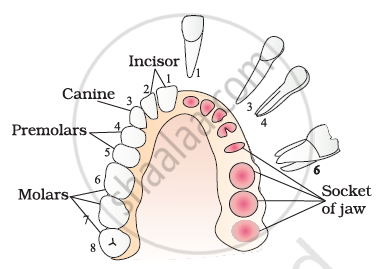Advertisements
Advertisements
Question
Explain the term thecodont and diphyodont.
Solution 1
Thecodont: In human, each tooth is embedded in a socket of jaw bone. Such teeth are described as thecodont.
Diphyodont: Majority of mammals including human beings form two sets of teeth during their life, a set of temporary milk or deciduous teeth replaced by a set of permanent or adult teeth. This type of dentition is called diphyodont
Solution 2
Thecodont is a type of dentition in which the teeth are embedded in the deep sockets of the jaw bone. Ankylosis is absent and the roots are cylindrical.

Examples include living crocodilians and mammals.
Diphyodont is a type of dentition in which two successive sets of teeth are developed during the lifetime of the organism. The first set of teeth is deciduous and the other set is permanent.
The deciduous set of teeth is replaced by the permanent adult teeth.
This type of dentition can be seen in humans
APPEARS IN
RELATED QUESTIONS
Answer briefly:
Why are villi present in the intestine and not in the stomach?
What are the basic layers of the wall of alimentary canal?
Discuss the main steps in the digestion of proteins as the food passes through different parts of the alimentary canal.
Types of teeth in human are ______.
Number of premolars in human is ______.
A gland not associated with the alimentary canal is ______.
Match the two columns and select the right one among options given
| Column I | Column II |
| A. Duodenum | i. A cartilaginous flap |
| B. Epiglottis | ii. Small blind sac |
| C. Glottis | iii. ‘U’ shaped structure emerging from the stomach |
| D. Caecum | iv. Opening of wind pipe |
Dental formula in human beings is ______.
What do we call the type of teeth attachment to jaw bones in which each tooth is embedded in a socket of jaws bones?
Stomach is located in upper left portion of the abdominal cavity and has three major parts. Name these three parts.
Explain the process of digestion in the buccal cavity with a note on the arrangement of teeth.
